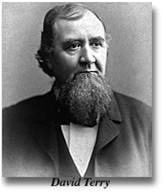End date 1890 | ||
 | ||
Citations 135 U.S. 1 (more)10 S. Ct. 658; 34 L. Ed. 55; 1890 U.S. LEXIS 2006 Prior history Appeal from the Circuit Court of the United States for the Northern District of California Majority Miller, joined by Bradley, Harlan, Gray, Blatchford, Brewer Dissent Lamar, joined by Fuller Similar Myers v United States, Clinton v City of New York, United States v Curtiss‑W, Humphrey's Executor v United St, Youngstown Sheet & Tube Co | ||
In re Neagle, 135 U.S. 1 (1890), is a United States Supreme Court decision holding that the Attorney General of the United States was authorized to appoint U.S. Marshals as bodyguards to federal judges.
Facts
U.S. Marshal David B. Neagle (1847-1925) was appointed by the United States Attorney General to serve as Justice Stephen J. Field's bodyguard while Field rode circuit in California. On 14 August 1889, David S. Terry approached Field inside the Lathrop, California train station in California's San Joaquin Valley. Terry, a former California Supreme Court justice, had a grudge with Field. Fearing Terry was about to attack Field, Neagle shot and killed Terry. Field and Neagle were arrested by the San Joaquin Sheriff, Thomas Cunningham. Cunningham later released Field on his own recognizance but took Neagle to jail.
The United States Attorney in San Francisco filed a writ of habeas corpus for Neagle's release. The circuit court issued the writ after a hearing and ordered Neagle's release. Sheriff Cunningham, with the aid of the State of California, appealed to the United States Supreme Court. In a 6-2 decision (Justice Field abstained), the Supreme Court affirmed the lower court. The decision was a significant expansion of executive authority because there was no specific law authorizing the President to provide protection to federal judges.
